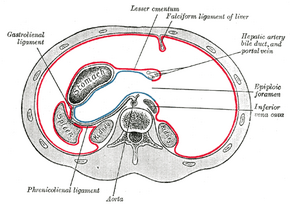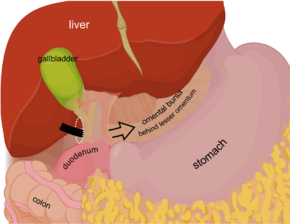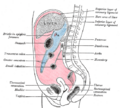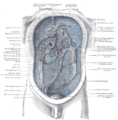Medicine:Omental foramen
From HandWiki
Short description: Part of the human abdomen
| Omental foramen | |
|---|---|
 Horizontal disposition of the peritoneum in the upper part of the abdomen. | |
 Entry to omental bursa (black arrow) by omental foramen (white mark) | |
| Details | |
| Identifiers | |
| Latin | foramen omentale |
| Anatomical terminology | |
In human anatomy, the omental foramen (epiploic foramen, foramen of Winslow after the anatomist Jacob B. Winslow, or uncommonly aditus; Latin: Foramen epiploicum) is the passage of communication, or foramen, between the greater sac (general cavity (of the abdomen)), and the lesser sac.
Borders
It has the following borders:
- anterior: the free border of the lesser omentum, known as the hepatoduodenal ligament. This has two layers and within these layers are the common bile duct, hepatic artery, and hepatic portal vein.
- posterior: the peritoneum covering the inferior vena cava
- superior: the peritoneum covering the caudate lobe of the liver
- inferior: the peritoneum covering the commencement of the duodenum and the hepatic artery, the latter passing forward below the foramen before ascending between the two layers of the lesser omentum.
- left lateral: gastrosplenic ligament and splenorenal ligament
As the portal vein is the most posterior structure in the hepatoduodenal ligament, and the inferior vena cava lies under the posterior wall, the epiploic foramen can be remembered as lying between the two great veins of the abdomen.
Additional images
See also
- Terms for anatomical location
- Omental bursa (Lesser sac)
- Greater sac
- Lesser omentum
- Greater omentum
- Peritoneum
References
External links
- "Omental foramen". Medcyclopaedia. GE. http://www.medcyclopaedia.com/library/topics/volume_ii/f/omental%20foramen.aspx.
- Anatomy photo:37:08-0100 at the SUNY Downstate Medical Center – "Abdominal Cavity: The Omental Foramen"
- Anatomy image:7826 at the SUNY Downstate Medical Center
- Anatomy image:7831 at the SUNY Downstate Medical Center
- Anatomy image:7875 at the SUNY Downstate Medical Center
- peritoneum at The Anatomy Lesson by Wesley Norman (Georgetown University)
- abdominalcavity at The Anatomy Lesson by Wesley Norman (Georgetown University) (xsectthrulesseromentum)
 |




